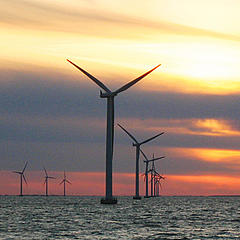This dispatch came in from Alison van Diggelen after a recent visit to her home country. Van Diggelen is a freelance writer and interviewer and founder of the Fresh Dialogues website and podcast. Originally from Glasgow, she now makes her home in Silicon Valley.
Scotland Aims to Beat California on Climate Change Action
By Alison van Diggelen

It’s not often that Scotland is ahead of the game compared to California, but on the issue of climate change, this small northern country has taken a legislative lead that has put it on the green map of the world.
As the California Legislature this week grapples with new laws* requiring utilities to get 33% of their energy from renewable sources by 2020, Scotland is sitting pretty. It is already close to its 31% target of energy from renewables by 2011 and has an even bolder target of 50% by 2020.
On a trip to Scotland this summer, I met with Lena Wilson, CEO of Scottish Enterprise, a government-funded organization that promotes Scottish interests both at home and abroad. She told me that the fight against global warming is a crucial part of the government’s strategy because ultimately a low carbon future is an economic stimulus and job creator for the country.
But how did Scotland muster the political will to set such ambitious targets? Scotland’s First Minister, Alex Salmond is passionate about renewable energy, Wilson told me; and establishing Scotland as a hub of green energy and green-tech is key to his strategy. Part of the plan is to harness its natural resources – powerful wind and wave power, estimated to account for a quarter of Europe’s potential. Salmond recently opened the largest wind farm in Europe to drive home that point. It’s on the outskirts of my home town of Glasgow and makes me rather proud.
Yet, making bold targets isn’t the end of the story. Scotland must create a whole ecosystem to make green growth attractive in Scotland. It launched the Saltire Prize last year to stimulate innovation in wave and tidal power; but still has ground to cover. As well as the financial, administrative and logistical challenges, there’s the issue of NIMBY-ism. Although Wilson insisted they’re pursing a popular green agenda, some of the locals I talked to in Scotland were less enthusiastic about the aesthetics of wind turbines.
And then there’s the “nuclear option.” Just as in California, the issue is red hot. Salmond is publically against it, but if he wants to keep shining his low carbon credentials, he may be forced to rethink his position.
One final note: When I asked Wilson, is your boss, Alex Salmond the Al Gore of Scotland? Her response was enlightening. She almost choked. Being a staunch nationalist, union man and former socialist, she doubted he’d enjoy the comparison. On my next trip, I hope to discuss this with the man himself and find out exactly how his passion for green took root. Stay tuned.
*State legislators passed two bills during their overnight session on Friday. Here’s a summary provided by the advocacy group Environment California:
“AB 64 (Krekorian) & SB 14 (Simitian): AB 64 and SB 14 are companion bills that together set California on the path toward producing 33% of its electricity from renewable resources like solar and wind power. While there was much controversy over amendments to the bill that add in language for PG&E to potentially build large hydroelectric dams in British Columbia and call it renewable energy as well as amendments pushed by British Petroleum and Chevron that put 7,000 MW of fossil fuel burning combined heat and power plants ahead of renewable energy, the two bills still stand to become the biggest renewable energy mandate in the country”
3 thoughts on “Scotland Rising to Carbon Challenge”
Comments are closed.

Why did you write, “but if he wants to keep shining his low carbon credentials, he may be forced to rethink his position“?
Nuclear is not required for even a zero-carbon grid. If it were, we would be in serious trouble, as there are not enough supernova remnants (U235 and Th232) economically accessible by zero-carbon means to power the world with nuclear. There are about 2,600 EJ of U235, and 11,000 EJ of Th232 to be burned. Breeder reactors would let us exploit U238, which is much more plentiful, but the world has so far rejected this option because of proliferation concerns (how do you trade off electric power with a mushroom cloud over a city?).
Earth’s annual solar insolation is about ten times all the energy that could be gotten from burning U238 in breeder reactors. Isn’t that the first place to look?
Earl
Don’t get me wrong. I am not advocating for nuclear power, but am aware that in Scotland the issue is very contentious. Although First Minister Alex Salmond is strongly against it, there is a vocal lobby arguing it IS a carbon free alternative to coal or oil http://business.scotsman.com/energyutilities/Nuclear-lobby-tries-to-generate.4573361.jp
It sounds like Scotland is setting an example worth exploring, through laws and rewards.
Although wind turbines off the California coast could probably genereate measurable energy, I side with those in Scotland that question the aesthetics of that solution.
It is exciting news to hear that California has taken the first step by passing aggressive new environmental laws. These laws coupled with appropraite rewards should motivate innovators to find new solar and tidal power technologies that would not only meet the state’s requirements but stimulate our economy through innovation. After all, isn’t that a California trademark?